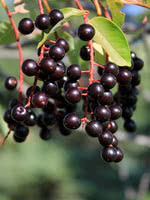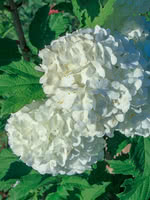Mon-Fri 9am - 5pm Mountain time
Western Chokecherry vs Snowball Viburnum
Prunus virginiana var. demissa
Viburnum opulus roseum
Western Chokecherry is a shrub or small tree commonly used for farmstead and field windbreaks.
It produces white flowers in the spring and edible dark purple fruit that matures between September and October. Its cherries are great for making for making jams, jellies or wine, but are not very palatable for raw eating.
Snowball Viburnum is a popular ornamental shrub with prolific flowering. This plant is prized for its round clusters of white flowers that resemble snowballs, delighting children and adults. In fall, its leaves turn vibrant shades of red.
Snowball Viburnum is sought after as a single accent shrub, but can also make a dense hedge or privacy screen.
Western Chokecherry Quick Facts
Snowball Viburnum Quick Facts
Toxicity: toxic to horses, cattle, etc.)

